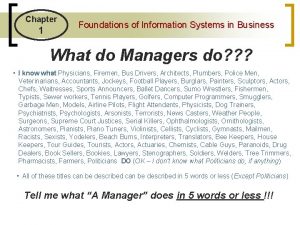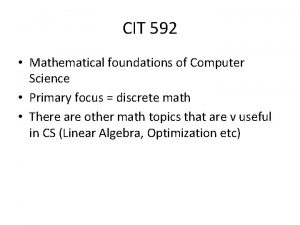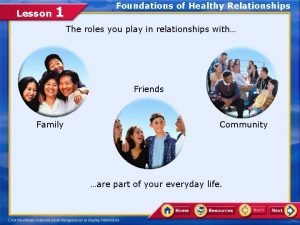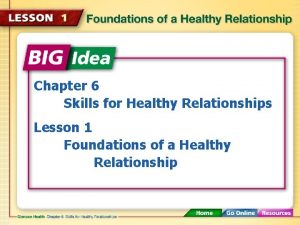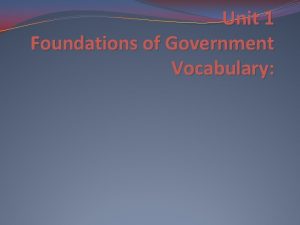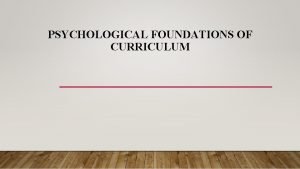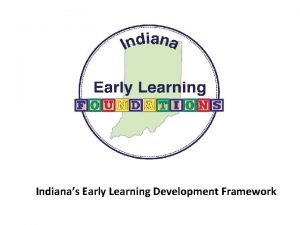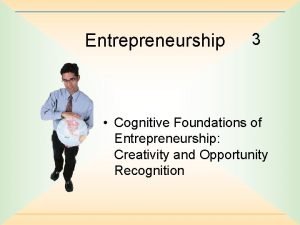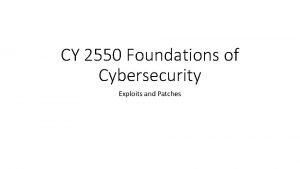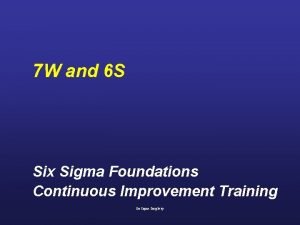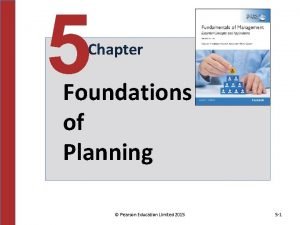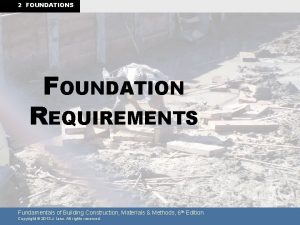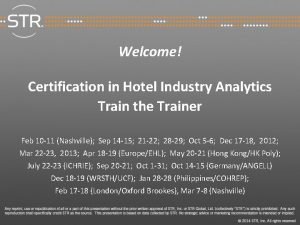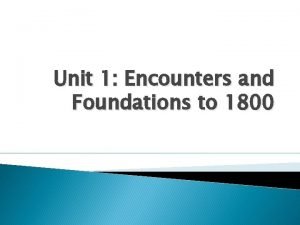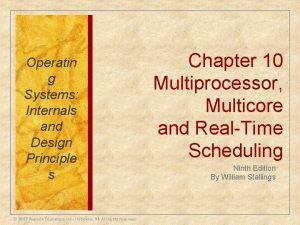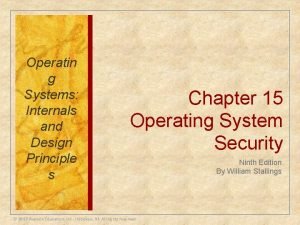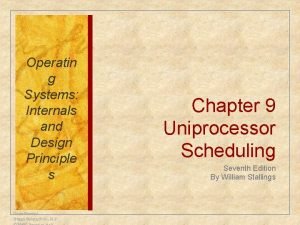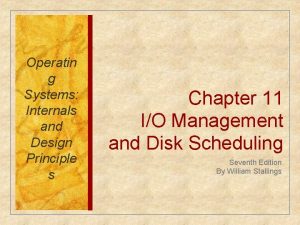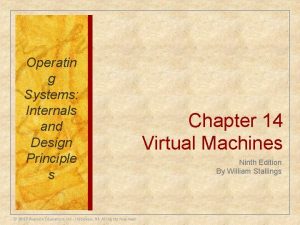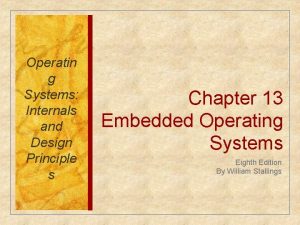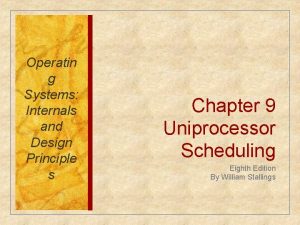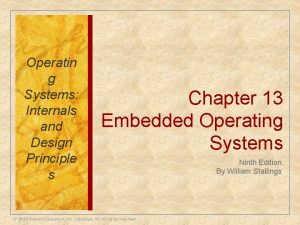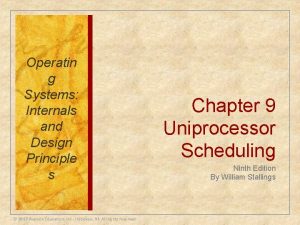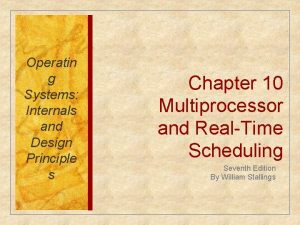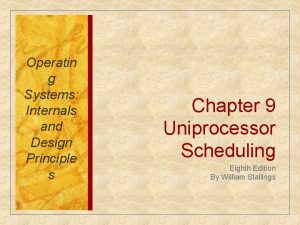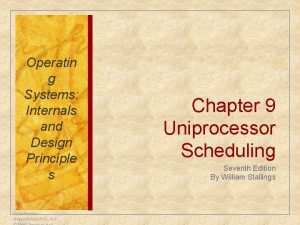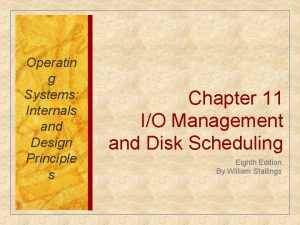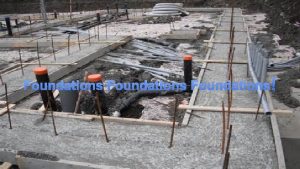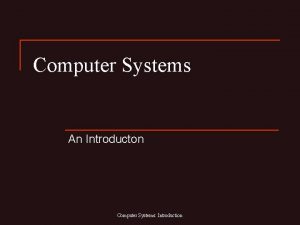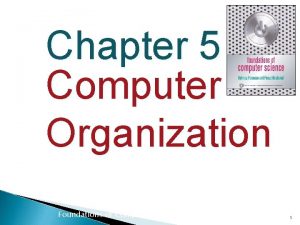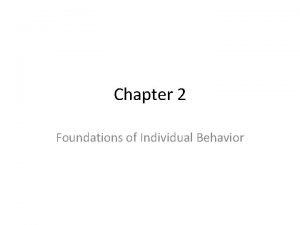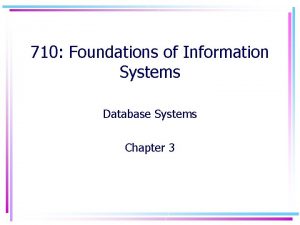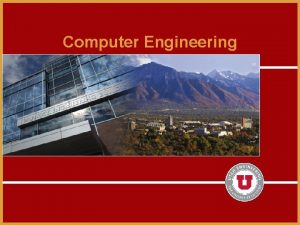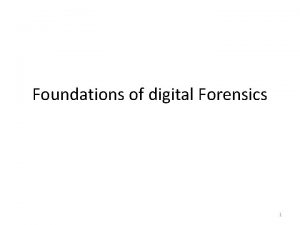Chapter 7 Operatin g Systems Foundations of Computer





















![Paging [cont. ] The advantage of paging over partitioning is that there is no Paging [cont. ] The advantage of paging over partitioning is that there is no](https://slidetodoc.com/presentation_image_h/bec32458435d3b0850c58ef977165cdd/image-22.jpg)









![Schedulers [cont. ] § Process scheduler is responsible for moves the process from: § Schedulers [cont. ] § Process scheduler is responsible for moves the process from: §](https://slidetodoc.com/presentation_image_h/bec32458435d3b0850c58ef977165cdd/image-32.jpg)




![1 - Deadlock [cont. ] Figure 7. 17 Deadlock on a bridge 1 - Deadlock [cont. ] Figure 7. 17 Deadlock on a bridge](https://slidetodoc.com/presentation_image_h/bec32458435d3b0850c58ef977165cdd/image-37.jpg)

![2 - Starvation [cont. ] Figure 7. 19 The dining philosophers problem i Starvation 2 - Starvation [cont. ] Figure 7. 19 The dining philosophers problem i Starvation](https://slidetodoc.com/presentation_image_h/bec32458435d3b0850c58ef977165cdd/image-39.jpg)


- Slides: 41

Chapter 7 Operatin g Systems Foundations of Computer Science ã Cengage Learning

Objectives q Understand the role of the operating system. q Understand the process of bootstrapping to load the operating system into memory. q List the components of an operating system. q Discuss the role of the memory manager. q Discuss the role of the process manager. q Discuss the role of the device manager. q Discuss the role of the file manager in an operating system. q Understand the main features of three common operating systems: UNIX, Linux and Windows NT.

A computer is a system composed of two major components: Ø Computer hardware: the physical equipment. Ø Computer software: the collection of programs that allows the hardware to do its job. Computer software is divided into two broad categories: § Operating system controls the access to hardware by users. § Application programs use the computer hardware to solve users’ problems.

Figure 7. 1 A computer system

7 -1 INTRODUCTION An operating system is complex, so it is difficult to give a simple universal definition. Instead, here are some common definitions: q An operating system is an interface between the hardware of a computer and the user (programs or humans). q An operating system is a program (or a set of programs) that facilitates the execution of other programs. q An operating system acts as a general manager supervising the activity of each component in the computer system.

i An operating system is an interface between the hardware of a computer and the user (programs or humans) that facilitates the execution of other programs and the access to hardware and software resources. Two major design goals of an operating system are: ❑ Efficient use of hardware. ❑ Ease of use of resources.

Bootstrap process The operating system, based on the above definitions, provides supports for other programs. For example, it is responsible for loading other programs into memory for execution. However, the operating system itself is a program that needs to be loaded into the memory and be run. How is this dilemma solved? The solution is a two-stage process. A very small section of memory is made of ROM and holds a small program called the bootstrap program. When the computer is turned on, the CPU counter is set to the first instruction of this bootstrap program and executes the instructions in this program. When loading is done, the program counter is set to the first instruction of the operating system in RAM.

Figure 7. 2 The bootstrap process

7 -2 EVOLUTION Operating systems have gone through a long history of evolution, which we summarize here. Batch systems Batch operating systems were designed in the 1950 s to control mainframe computers. At that time, computers were large machines that used punched cards for input, line printers for output and tape drives for secondary storage media. Each program to be executed was called a job. A programmer who wished to execute a job sends a request to the operating system.

Time-sharing systems To use computer system resources efficiently, multiprogramming was introduced. The idea is to hold several jobs in memory at a time, and only assign a resource to a job that needs it on the condition that the resource is available. Multiprogramming brought the idea of time sharing: resources could be shared between different jobs, with each job being allocated a portion of time to use a resource. Because a computer is much faster than a human, time sharing is hidden from the user—each user has the impression that the whole system is serving them exclusively.

Personal systems When personal computers were introduced, there was a need for an operating system for this new type of computer. During this era, singleuser operating systems such as DOS (Disk Operating System) were introduced. Parallel systems The need for more speed and efficiency led to the design of parallel systems: multiple CPUs on the same machine. Each CPU can be used to serve one program or a part of a program, which means that many tasks can be accomplished in parallel instead of serially. The operating systems required for this are more complex than those that support single CPUs.

Distributed systems Networking and internetworking have created a new dimension in operating systems. A job that was previously done on one computer can now be shared between computers that may be thousands of miles apart. Distributed systems combine features of the previous generation with new duties such as controlling security. Real-time systems A real-time system is expected to do a task within a specific time constraint. They are used with real-time applications, which monitor, respond to or control external processes or environments.

7 -3 COMPONENTS Today’s operating systems are very complex. An operating system needs to manage different resources in a computer system. It resembles an organization with several managers at the top level. Each manager is responsible for managing their department, but also needs to cooperate with others and coordinate activities. A modern operating system has at least four duties: memory manager, process manager, device manager and file manager.

Figure 7. 3 Components of an operating system

User interface Each operating system has a user interface, a program that accepts requests from users (processes) and interprets them for the rest of the operating system. A user interface in some operating systems, such as UNIX, is called a shell. In others, it is called a window to denote that it is menu driven and has a GUI (graphical user interface) component.

Memory manager One of the responsibilities of a modern operating system is memory management. Although the memory size of computers has increased tremendously in recent years, so has the size of the programs and data to be processed. Memory allocation must be managed to prevent applications from running out of memory. Operating systems can be divided into two broad categories of memory management: • monoprogramming • multiprogramming.

Monoprogramming In monoprogramming, most of the memory capacity is dedicated to a single program; only a small part is needed to hold the operating system. In this configuration, the whole program is in memory for execution. When the program finishes running, the program area is occupied by another program. - The job of the memory manager is straightforward. - There are several problems with this technique. (see book) Figure 7. 4 Monoprogramming

Multiprogramming In multiprogramming, more than one program is in memory at the same time, and they are executed concurrently, with the CPU switching rapidly between the programs. Figure 7. 5 Multiprogramming

Figure 7. 6 Categories of multiprogramming ü Nonswapping category means that the program remains in the memory for the duration of execution. ü Swapping category means that during the execution, the program can be swapped between memory and disk one or more times.

Partitioning In this schema, the memory is divided into variable-length sections. Each section or partition holds one program. The CPU switches between programs. (see book) With this technique, each program is entirely in memory and occupying contiguous locations. Partitioning improves the efficiency of the CPU, but there are still some issues: (see book) Figure 7. 7 Partitioning

Paging In this schema, the memory is divided into equally sized sections called frames. Programs are also divided, into equally sized sections called pages. A page is loaded into a frame in memory (have the same size). With this technique, the program does not have to be contiguous in memory. Figure 7. 8 Paging
![Paging cont The advantage of paging over partitioning is that there is no Paging [cont. ] The advantage of paging over partitioning is that there is no](https://slidetodoc.com/presentation_image_h/bec32458435d3b0850c58ef977165cdd/image-22.jpg)
Paging [cont. ] The advantage of paging over partitioning is that there is no need for three new program to wail until six contiguous frames are free before being loaded into memory. The disadvantage is that the whole program still needs to be in memory before being executed. (like partitioning). Figure 7. 8 Paging

Demand Paging In this technique, the program is divided into pages. But the pages can be loaded into memory one by one, executed, and replaced by another page. Figure 7. 9 Demand paging

Demand Segmentation In this technique, the program is divided into segments that match the programmer’s view (module). These are loaded into memory, executed, and replaced by another module from the same or a different program. Since segments in memory are of equal size, part of a segment may remain empty. Figure 7. 10 Demand segmentation

Demand paging and segmentation can be combined to further improve the efficiency of the system. Memory can be divided into frames, and a module can be divided into pages. The pages of a module can then be loaded into memory one by one and executed.

Virtual memory Demand paging and demand segmentation mean that, when a program is being executed, part of the program is in memory and part is on disk. This means that, for example, a memory size of 10 MB can execute 10 programs, each of size 3 MB, for a total of 30 MB. At any moment, 10 MB of the 10 programs are in memory and 20 MB are on disk. There is therefore an actual memory size of 10 MB, but a virtual memory size of 30 MB. Figure 7. 11 shows the concept. Virtual memory, which implies demand paging, demand segmentation or both, is used in almost all operating systems today.

Figure 7. 11 Virtual memory

Process manager A second function of an operating system is process management, but before discussing this concept, we need to define some terms. Program, job, and process q A program is a non-active set of instructions stored on disk. q A program becomes a job from the moment it is selected for execution until it has finished running and becomes a program again. q A process is a program in execution. It is a program that has started but has not finished.

State diagrams The relationship between a program, a job and a process becomes clearer if we consider how a program becomes a job and how a job becomes a process. This can be illustrated with a state diagram that shows the different states of each of these entities.

Figure 7. 12 State diagram with boundaries between program, job and process

Schedulers To move a job or process from one state to another, the process manager uses two schedulers: the job scheduler and the process scheduler. § Job scheduler is responsible for creating a process from a job and terminating a process. Figure 7. 13 Job scheduler
![Schedulers cont Process scheduler is responsible for moves the process from Schedulers [cont. ] § Process scheduler is responsible for moves the process from: §](https://slidetodoc.com/presentation_image_h/bec32458435d3b0850c58ef977165cdd/image-32.jpg)
Schedulers [cont. ] § Process scheduler is responsible for moves the process from: § Running state to the waiting state when the process is waiting for some event to happen. § Waiting state to the ready state when the event has occurred. § Running state to the ready state when the process’ time allotment has expired. § Ready state to the running state when the CPU is ready to run the process. Figure 7. 14 Process scheduler

Queuing Our state diagram shows one job or process moving from one state to another. In reality, there are many jobs and many processes competing with each other for computer resources. To handle multiple processes and jobs, the process manager uses queues (waiting lists). A job control block or process control block is associated with each job or process. This is a block of memory that stores information about that job or process. The process manager stores the job or process control block in the queues instead of the job or process itself.

Figure 7. 15 Queues for process management

Process synchronization The whole idea behind process management is to synchronize different processes with different resources. Whenever resources can be used by more than one user (or process, in this case), we can have two problematic situations: deadlock and starvation.

1 - Deadlock It occurs if the operating system allows a process to start running without first checking to see if the required resources are ready, and allows a process to hold a resource as long as it wants. Deadlock occurs when the operating system does not put resource restrictions on processes. Figure 7. 16 Deadlock
![1 Deadlock cont Figure 7 17 Deadlock on a bridge 1 - Deadlock [cont. ] Figure 7. 17 Deadlock on a bridge](https://slidetodoc.com/presentation_image_h/bec32458435d3b0850c58ef977165cdd/image-37.jpg)
1 - Deadlock [cont. ] Figure 7. 17 Deadlock on a bridge

2 - Starvation Figure 7. 18 Starvation
![2 Starvation cont Figure 7 19 The dining philosophers problem i Starvation 2 - Starvation [cont. ] Figure 7. 19 The dining philosophers problem i Starvation](https://slidetodoc.com/presentation_image_h/bec32458435d3b0850c58ef977165cdd/image-39.jpg)
2 - Starvation [cont. ] Figure 7. 19 The dining philosophers problem i Starvation is the opposite of deadlock. It can happen when the operating system puts too many resource restrictions on a process.

Device manager The device manager, or input/output manager, is responsible for access to input/ output devices. There are limitations on the number and speed of input/output devices in a computer system. The device manager is responsible for the efficient use of input/output devices. It responsibilities are: q The device manager monitors every input/output device constantly to ensure that the device is functioning properly. q The device manager maintains a queue for each input/output device or one or more queues for similar input/output devices. q The device manager controls the different policies for accessing input/output devices.

File manager Operating systems today use a file manager to control access to files. The file manager: q controls access to files. q supervises the creation, deletion, and modification of files. q controls the naming of files. q supervises the storage of files. q is responsible for archiving and backups.
 Foundations of information systems
Foundations of information systems Mathematical foundations of computer graphics and vision
Mathematical foundations of computer graphics and vision Cit592
Cit592 Foundations of a healthy relationship
Foundations of a healthy relationship Chapter 6 skills for healthy relationships
Chapter 6 skills for healthy relationships Chapter 2 the nursing assistant and the care team
Chapter 2 the nursing assistant and the care team Foundations of individual behaviour
Foundations of individual behaviour Lesson 1 purposes and origins of government
Lesson 1 purposes and origins of government Chapter 4 foundations background to american history
Chapter 4 foundations background to american history Chapter 1: introduction to personal finance
Chapter 1: introduction to personal finance Ultimate frisbee vocabulary
Ultimate frisbee vocabulary Chapter 1: foundations of government pdf
Chapter 1: foundations of government pdf Foundations of government (chapter 1 test form a)
Foundations of government (chapter 1 test form a) Decision support systems and intelligent systems
Decision support systems and intelligent systems Dicapine
Dicapine Embedded systems vs cyber physical systems
Embedded systems vs cyber physical systems Engineering elegant systems: theory of systems engineering
Engineering elegant systems: theory of systems engineering The foundations logic and proofs
The foundations logic and proofs The foundations logic and proofs
The foundations logic and proofs California preschool curriculum framework
California preschool curriculum framework Learning is explained in terms of wholeness of the problem
Learning is explained in terms of wholeness of the problem New foundations home for children
New foundations home for children Indiana early learning foundations
Indiana early learning foundations History and geography: the foundations of culture
History and geography: the foundations of culture Example of biographical characteristics
Example of biographical characteristics Foundations of business 5th edition
Foundations of business 5th edition Cognitive foundations of entrepreneurship
Cognitive foundations of entrepreneurship Cognitive foundations of entrepreneurship
Cognitive foundations of entrepreneurship Hello party
Hello party California preschool foundations
California preschool foundations Preschool learning foundations volume 1
Preschool learning foundations volume 1 Aohs foundations of anatomy and physiology 1
Aohs foundations of anatomy and physiology 1 Aohs foundations of anatomy and physiology 1
Aohs foundations of anatomy and physiology 1 Foundations and earth retaining structures
Foundations and earth retaining structures Preschool learning foundations volume 3
Preschool learning foundations volume 3 6 s sigma
6 s sigma Foundations of planning
Foundations of planning Fundamentals of building construction chapter summaries
Fundamentals of building construction chapter summaries Preschool learning foundations social emotional
Preschool learning foundations social emotional California preschool learning foundations
California preschool learning foundations Hotel industry analytics
Hotel industry analytics Encounters and foundations to 1800
Encounters and foundations to 1800
